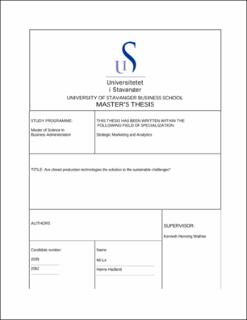Are closed production technologies the solution to the sustainable challenges?
Master thesis
Permanent lenke
https://hdl.handle.net/11250/2779047Utgivelsesdato
2021Metadata
Vis full innførselSamlinger
- Studentoppgaver (Business) [1023]
Sammendrag
Norwegian aquaculture is in a state of sustainable challenges that much be solved regardingtraditional open net-pen production infrastructure. The Norwegian aquaculture industry currentlyfinds itself in a state of sustainable challenges with the primary traditional open net-pen productioninfrastructure. These challenges have led to the stagnant production of salmon in recent years andrising production costs, even with the growing demand for protein-rich salmon. The governmentwants to invest in the aquaculture industry by increasing production by 2050 and increasing valuecreation in Norway. This has led to the radical technological development of land-based closedcontainment systems and sea-based semi-closed containment systems to potentially solve theenvironmental and biological challenges faced in the industry. Moreover, this phenomenon hasspurred the government to develop aquaculture permits intended to promote these technologicalproduction initiatives.
In this thesis, we seek to discover “What economic benefits does society achieve by basing furthergrowth on technology for closed facilities?” We achieve this through using an exploratoryqualitative method. This thesis is considered a comparative case study where the purpose is toprovide a basis for assessing the role of two types of closed-cage technologies and how it can playin further growth and development in Norwegian aquaculture. To answer the research question,we have collected primary data through qualitative interviews with Tytlandsvik Aqua andFishGLOBE, representing their respective closed technologies. Secondary data was collectedthrough archival and documentary research from various research reports, news articles, et cetera.Based on our qualitative research methods, we have conducted a cost-benefit analysis, productioncost calculations and sensitivity analysis to compare the closed-cage technologies against eachother.
The results show that there are advantages and disadvantages with both technologies, and it ischallenging to control microbial and chemical water quality. Findings indicate that land-basedfacilities are more expensive than semi-closed facilities, mainly due to various factors. Commonto both technologies is that they can solve the problem related to lice and diseases and reduce theclimate footprint. The technologies can thus lead to sustainable production growth while reducingenvironmental challenges. Furthermore, we discuss the implication of potential repercussions closed technologies can have on society. An increased production volume and implementation canboost the export industry to meet global demand and increase employment. Although the biggestobstacle to closed-cage implementation is the high capital cost, several environmental trade-offsare discussed, compensating for the high investment. Finally, findings imply fostering innovationand research and development for closed-cage technology to develop to its full potential. Today,combining both closed-cage and traditional open net-pen will be a potential solution, as it will onlybe a supplement to current production.
